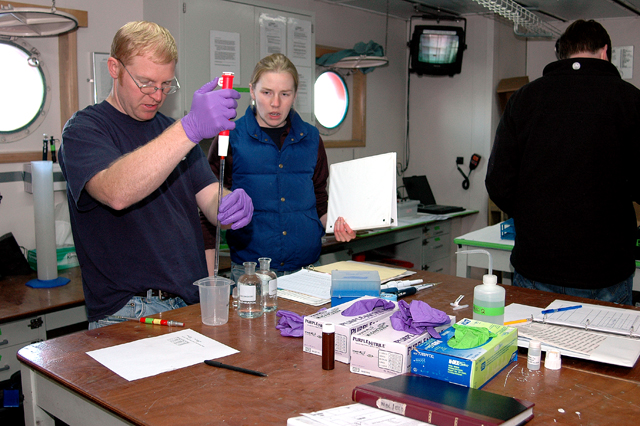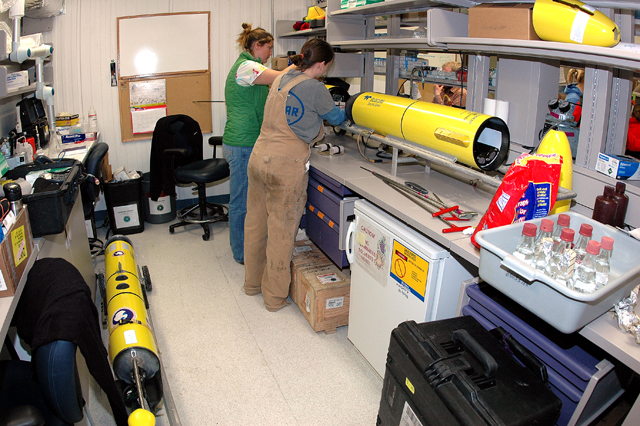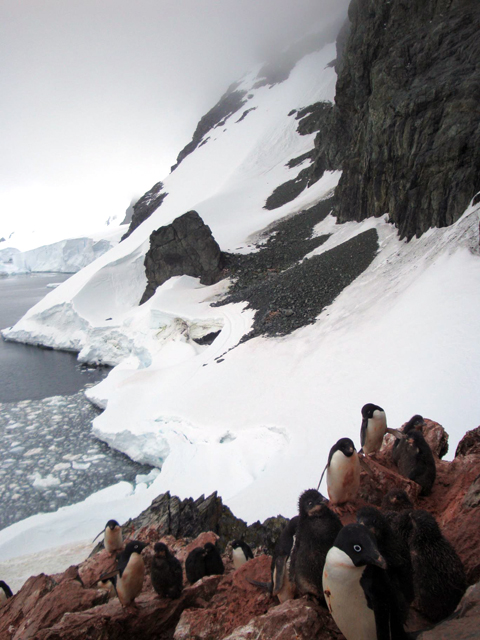Page 3/3 - Posted June 18, 2010
Hitting the spotThe torpedo-shaped robots have been particularly useful at the new “process” stations that the PAL LTER scientists have introduced to get away from the “snapshot” approach. Instead of just a hit-and-run at each grid station, the researchers spend at least three days at three different locations along their survey area, devoting about a third of their field season to these more in-depth studies. Each spot — one in the far north close to Palmer Station, a second in the middle at a place called Marguerite Bay and a third at the end of the line near Charcot Island — focuses on a deep depression cut into the continental shelf. The scientists have found these canyons are hotspots for wildlife, particularly Adélie penguin colonies. “There are ocean processes funneling nutrients and slightly warmer ocean water up these canyons,” Ducklow said. “We really want to find out the mechanisms that connect these canyons, ocean circulation, productivity and penguins.” For instance, on Avian Island in Marguerite Bay, home to more than 60,000 breeding pairs of Adélie penguins, two members of Fraser’s team put satellite transmitters on several of the birds, which track their movements while foraging in the water. Schofield’s team then release one of their gliders to learn more about the ocean properties in the area favored by the penguins. “We’re now able to take oceanographic measurements and team it with penguin measurements and get a bigger picture of why the penguins doing what they’re doing,” noted Tina Haskins Next year, one glider will be outfitted with acoustic sensors to see if the canyons are also hotspots for krill and other zooplankton, according to Steinberg. “That’s one great thing about the LTER: There’s all these different components. The things you can’t do yourself, there are people on board who know how to do it,” Steinberg said. “I like working in these big, interdisciplinary programs for that reason.” In addition, the PAL LTER team recruited a group from Woods Hole Oceanographic Institution “Nobody has made those trace metal measurements before in this region, so that’s a nice addition for us as well,” Ducklow noted. Pushing southMarguerite Bay, in the middle of the PAL LTER ocean grid, used to be the endgame for the long-term science program. But even there the climate has changed, and the thriving Adélie community on Avian could start feeling the effects in the next decade or so. The scientists needed a sort of polar equivalent of Eden — Antarctica before the fall of sea ice — to appreciate how far the northern extremity has changed. The ecological time travel now ends at Charcot Island, where the Gould first ventured during the 2008-09 field season and returned this past year, despite even thicker sea ice. That first visit a year ago excited both veteran and rookies on the expedition when the vast field of sea ice appeared. “We were on the bridge almost cheering, ‘Look there is sea ice, there really is sea ice here,’” Ducklow recalled. The team believed there would be a canyon near Charcot Island as there was near Palmer and Avian. If so, that meant there might be an Adélie penguin colony, too. Both hunches proved to be true. In 2009, the scientists found a “bedraggled” colony with a few chicks clinging to a steep rock face on Charcot. This year, the Gould mapped the extent of the canyon for about 25 kilometers. “It’s a completely new canyon. It wasn’t on any of the other bathymetric charts. It really was a lot of fun,” Ducklow said following the end of the cruise, en route back to Punta Arenas. “Mapping that out for the first time lent a discovery aspect to the cruise — an exploration flavor to the cruise.” Of course, each new discovery leads to new questions. What are the different ocean processes at work in these canyons? How much heat is coming up from the deep ocean? Is more carbon being sequestered in the south of the peninsula versus the north? Why was the greatest amount of biological activity — from microbial to phytoplankton — near the sea ice edge at Charcot? These are hard questions to answer. Ducklow knows that it will take an increasingly complex science program to answer them. Going back in time is only the first step in understanding the future of the Antarctic Peninsula. “Palmer LTER is a really big, complicated thing. It takes a lot of choreography to do it well. And it takes a group that is committed to working together,” he said. “People need to be able to compromise their own specific aims to make the program work. We have a nice group of people who are just really doing a great job of that.” NSF-funded research in this story: Hugh Ducklow, Marine Biological Laboratory, Award No. 0823101 |



For USAP Participants |
For The Public |
For Researchers and EducatorsContact UsU.S. National Science FoundationOffice of Polar Programs Geosciences Directorate 2415 Eisenhower Avenue, Suite W7100 Alexandria, VA 22314 Sign up for the NSF Office of Polar Programs newsletter and events. Feedback Form |


.jpg)



